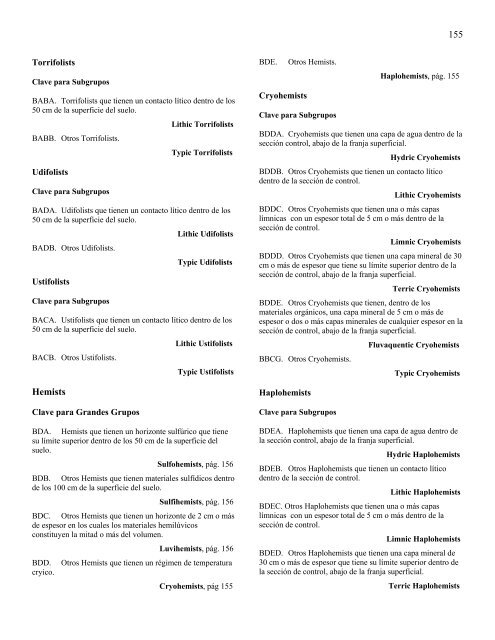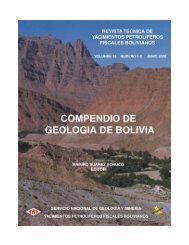Claves para la Taxonomía de Suelos
Create successful ePaper yourself
Turn your PDF publications into a flip-book with our unique Google optimized e-Paper software.
155<br />
Torrifolists<br />
C<strong>la</strong>ve <strong>para</strong> Subgrupos<br />
BABA. Torrifolists que tienen un contacto lítico <strong>de</strong>ntro <strong>de</strong> los<br />
50 cm <strong>de</strong> <strong>la</strong> superficie <strong>de</strong>l suelo.<br />
Lithic Torrifolists<br />
BABB. Otros Torrifolists.<br />
Typic Torrifolists<br />
Udifolists<br />
C<strong>la</strong>ve <strong>para</strong> Subgrupos<br />
BADA. Udifolists que tienen un contacto lítico <strong>de</strong>ntro <strong>de</strong> los<br />
50 cm <strong>de</strong> <strong>la</strong> superficie <strong>de</strong>l suelo.<br />
Lithic Udifolists<br />
BADB. Otros Udifolists.<br />
Typic Udifolists<br />
Ustifolists<br />
C<strong>la</strong>ve <strong>para</strong> Subgrupos<br />
BACA. Ustifolists que tienen un contacto lítico <strong>de</strong>ntro <strong>de</strong> los<br />
50 cm <strong>de</strong> <strong>la</strong> superficie <strong>de</strong>l suelo.<br />
Lithic Ustifolists<br />
BACB. Otros Ustifolists.<br />
Typic Ustifolists<br />
Hemists<br />
C<strong>la</strong>ve <strong>para</strong> Gran<strong>de</strong>s Grupos<br />
BDA. Hemists que tienen un horizonte sulfúrico que tiene<br />
su límite superior <strong>de</strong>ntro <strong>de</strong> los 50 cm <strong>de</strong> <strong>la</strong> superficie <strong>de</strong>l<br />
suelo.<br />
Sulfohemists, pág. 156<br />
BDB. Otros Hemists que tienen materiales sulfídicos <strong>de</strong>ntro<br />
<strong>de</strong> los 100 cm <strong>de</strong> <strong>la</strong> superficie <strong>de</strong>l suelo.<br />
Sulfihemists, pág. 156<br />
BDC. Otros Hemists que tienen un horizonte <strong>de</strong> 2 cm o más<br />
<strong>de</strong> espesor en los cuales los materiales hemilúvicos<br />
constituyen <strong>la</strong> mitad o más <strong>de</strong>l volumen.<br />
Luvihemists, pág. 156<br />
BDD. Otros Hemists que tienen un régimen <strong>de</strong> temperatura<br />
cryico.<br />
Cryohemists, pág 155<br />
BDE.<br />
Cryohemists<br />
Otros Hemists.<br />
C<strong>la</strong>ve <strong>para</strong> Subgrupos<br />
Haplohemists, pág. 155<br />
BDDA. Cryohemists que tienen una capa <strong>de</strong> agua <strong>de</strong>ntro <strong>de</strong> <strong>la</strong><br />
sección control, abajo <strong>de</strong> <strong>la</strong> franja superficial.<br />
Hydric Cryohemists<br />
BDDB. Otros Cryohemists que tienen un contacto lítico<br />
<strong>de</strong>ntro <strong>de</strong> <strong>la</strong> sección <strong>de</strong> control.<br />
Lithic Cryohemists<br />
BDDC. Otros Cryohemists que tienen una o más capas<br />
límnicas con un espesor total <strong>de</strong> 5 cm o más <strong>de</strong>ntro <strong>de</strong> <strong>la</strong><br />
sección <strong>de</strong> control.<br />
Limnic Cryohemists<br />
BDDD. Otros Cryohemists que tienen una capa mineral <strong>de</strong> 30<br />
cm o más <strong>de</strong> espesor que tiene su límite superior <strong>de</strong>ntro <strong>de</strong> <strong>la</strong><br />
sección <strong>de</strong> control, abajo <strong>de</strong> <strong>la</strong> franja superficial.<br />
Terric Cryohemists<br />
BDDE. Otros Cryohemists que tienen, <strong>de</strong>ntro <strong>de</strong> los<br />
materiales orgánicos, una capa mineral <strong>de</strong> 5 cm o más <strong>de</strong><br />
espesor o dos o más capas minerales <strong>de</strong> cualquier espesor en <strong>la</strong><br />
sección <strong>de</strong> control, abajo <strong>de</strong> <strong>la</strong> franja superficial.<br />
Fluvaquentic Cryohemists<br />
BBCG. Otros Cryohemists.<br />
Typic Cryohemists<br />
Haplohemists<br />
C<strong>la</strong>ve <strong>para</strong> Subgrupos<br />
BDEA. Haplohemists que tienen una capa <strong>de</strong> agua <strong>de</strong>ntro <strong>de</strong><br />
<strong>la</strong> sección control, abajo <strong>de</strong> <strong>la</strong> franja superficial.<br />
Hydric Haplohemists<br />
BDEB. Otros Haplohemists que tienen un contacto lítico<br />
<strong>de</strong>ntro <strong>de</strong> <strong>la</strong> sección <strong>de</strong> control.<br />
Lithic Haplohemists<br />
BDEC. Otros Haplohemists que tienen una o más capas<br />
límnicas con un espesor total <strong>de</strong> 5 cm o más <strong>de</strong>ntro <strong>de</strong> <strong>la</strong><br />
sección <strong>de</strong> control.<br />
Limnic Haplohemists<br />
BDED. Otros Haplohemists que tienen una capa mineral <strong>de</strong><br />
30 cm o más <strong>de</strong> espesor que tiene su límite superior <strong>de</strong>ntro <strong>de</strong><br />
<strong>la</strong> sección <strong>de</strong> control, abajo <strong>de</strong> <strong>la</strong> franja superficial.<br />
Terric Haplohemists
















